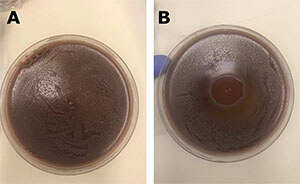
Microbes are giving us a new wave of defenses against hive pests and pathogens
Bacteria are not something to be cringed at. Villains like E. coli, Listeria, and Staphylococcus aureus have given the whole bacterial kingdom a bad rap, but we can capitalize on beneficial microbes to work for us instead of against us. Probiotic supplements are some of the first “good bacteria” products aimed at promoting honey bee health, but the fast-paced world of biotechnology is leading to increasingly creative applications, from genetically engineering gut bacteria to have better weapons against honey bee pathogens, to creating an anti-wax moth bacterial spritz to preserve stored comb.
Super Snodgrassella
Sofia Romero, a master’s student in Leonard Foster’s laboratory (where I completed my PhD), is looking for new ways to prevent American foulbrood infections without using antibiotics. Other research has focused on delivering AFB-fighting Lactobacillus bacteria to honey bees as part of a protein patty supplement (see Scott McArt’s article from January 2020, for more on this1), which is a promising approach.2 But instead of giving bees new bacteria, Romero is refurbishing an old one.
The goal is to engineer natural honey bee gut bacteria to manufacture antimicrobial peptides (small, bactericidal protein fragments), ramping up their potency against AFB. Romero has isolated the bacterium Snodgrassella alvi, which is one of the most abundant commensal bacteria in the honey bee’s gut, and is engineering it to produce and secrete the peptides melittin and jelleine, which kill AFB bacteria but have minimal effects on the bee’s natural microbiota. “I think having a probiotic with the ability to produce, deliver and secrete antimicrobial peptides is a highly rewarding approach,” Romero says. “It decreases the costs of the chemical synthesis of the peptides and provides a very convenient and safe method of delivery.”
Unlike animals, bacteria are very easy to genetically engineer — it’s so easy, this is routinely done in a single afternoon in a typical molecular biology laboratory. And since Snodgrassella is a normal part of the bee gut microbiome and gets passed on from worker to worker, a single inoculum could potentially maintain perpetual AFB resistance in the colony.
Romero’s research is still in early stages of development, and is not expected to lead to field trials any time soon. She is currently working on tweaking the bacteria’s secretion system to make sure the peptides actually become expelled. Romero recently won the Foundation for the Preservation of Honey Bees graduate student scholarship for her work on engineering Snodgrassella.
Lactobacillus BioPatties
Other probiotic approaches for fighting disease, like the BioPatty formula developed by PhD candidate Brendan Daisley and his colleagues at Western University,2 are making rapid progress. Daisley’s BioPatties, which include three Lactobacillus species (L. rhamnosus, L. kunkeei, and L. plantarum) that secrete AFB-fighting molecules, don’t use bacteria that have been genetically engineered. Rather, the researchers carefully selected specific strains that they previously demonstrated to have immunomodulatory properties. “Our strain selection for the Lactobacilli is very targeted,” Daisley says. “All the strains we test in bees have first been tested extensively in our Drosophila [fruit fly] model to determine their safety and ability to modulate insect detoxification and immunity. We’re trying to use microorganisms that have shown a benefit in model organisms and see if they can show the same benefit in honey bees as well.”
The researchers found that a Lactobacillus-supplemented diet reduced AFB pathogen loads in symptomatic colonies and increased larval survival in laboratory experiments, while other, independent work has shown that ….


